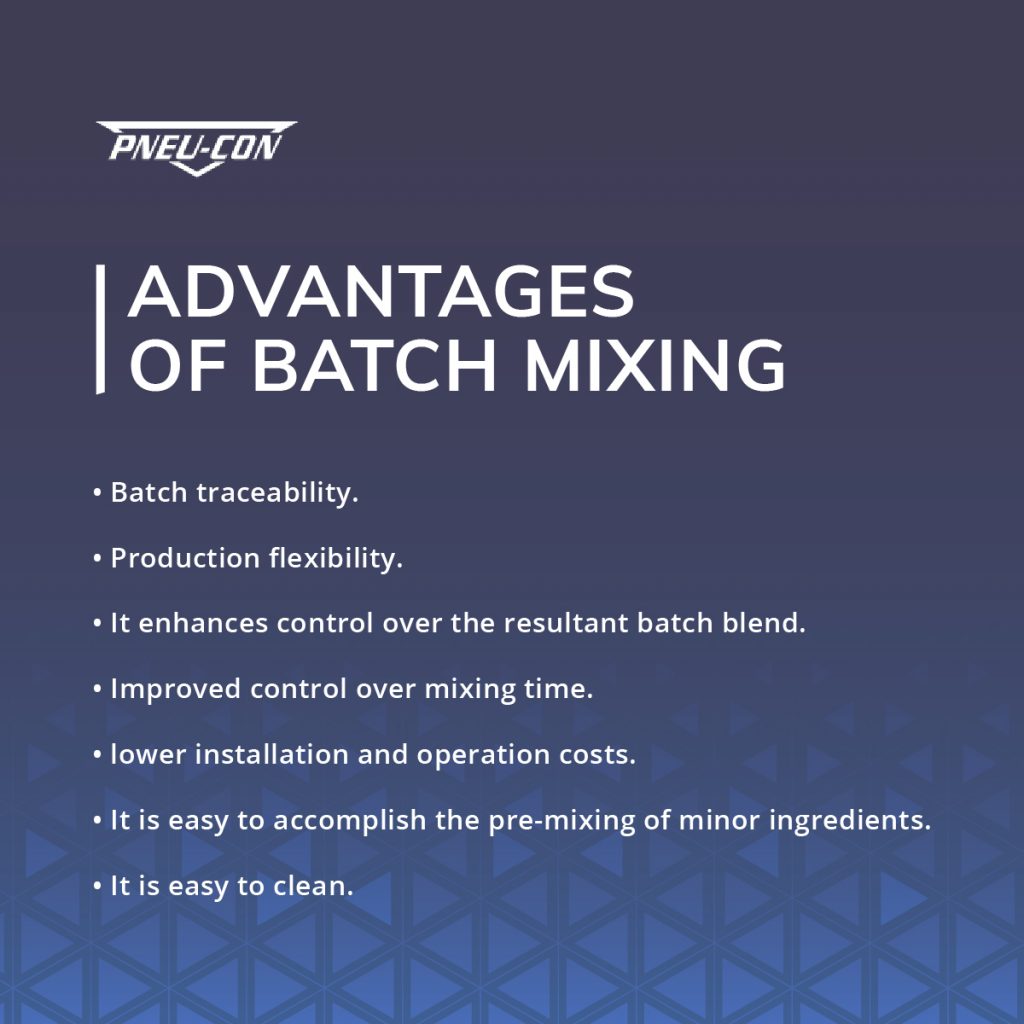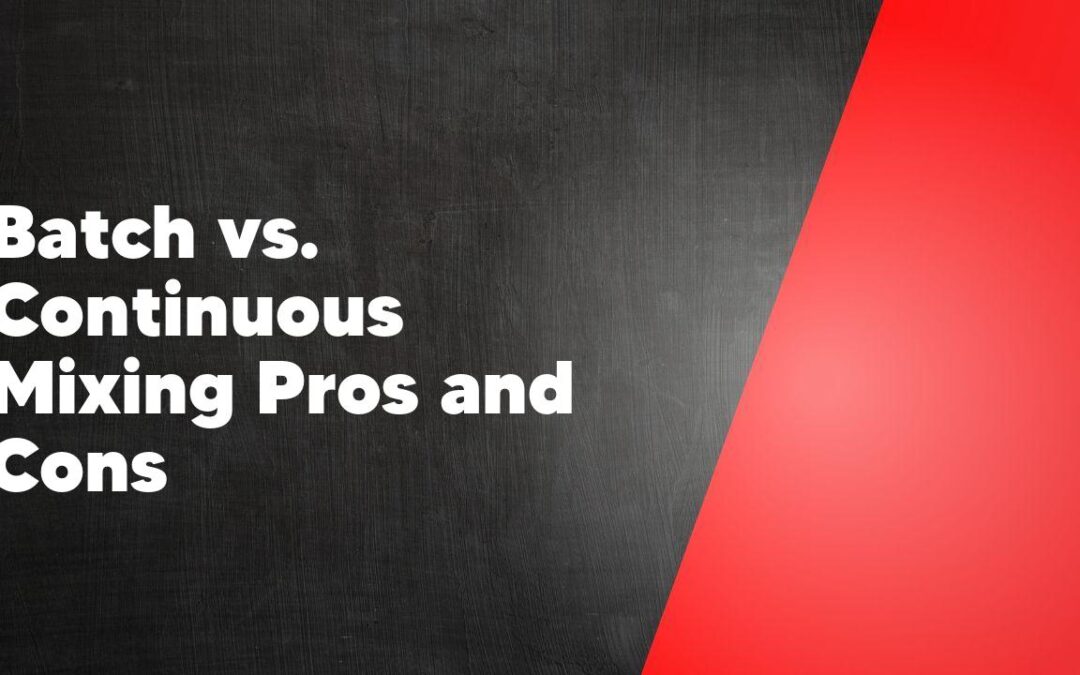In the field of manufacturing and construction, the process of mixing materials plays a crucial role in achieving desired outcomes. Two primary methods of mixing materials, batch mixing and continuous mixing, have been widely utilized in various industries. This article aims to highlight the pros and cons of both batch and continuous mixing, helping readers understand the differences and make informed decisions on which method to employ for their specific needs.
1. The Benefits of Batch Mixing in Industrial Processes
As an industrial engineer, I have witnessed firsthand the numerous advantages of implementing batch mixing in various industrial processes. Batch mixing allows for more precise control over the composition and consistency of products, ensuring superior quality and reducing the likelihood of defects or variations. This is especially beneficial in industries such as food and beverage, pharmaceuticals, and chemicals, where strict quality standards are crucial. Additionally, batch mixing allows for better utilization of equipment and resources, as multiple batches can be processed simultaneously, increasing efficiency and reducing production time. Overall, batch mixing has proven to be a valuable technique in enhancing product quality, optimizing resources, and improving overall productivity in industrial processes.
2. Advantages of Continuous Mixing in Production Environments

Continuous mixing offers several advantages in production environments. First and foremost, it allows for a steady and uninterrupted flow of materials, resulting in increased productivity and efficiency. With continuous mixing, there is no need to stop and start the process repeatedly, saving both time and resources. Additionally, continuous mixing enables better control over the quality of the final product. Since the mixing process is constant, it is easier to monitor and adjust any variables that may affect the desired outcome. Furthermore, continuous mixing reduces the risk of human error, as the entire process is automated and requires minimal intervention. Overall, the implementation of continuous mixing in production environments can greatly improve the overall performance and success of a manufacturing operation.
3. Understanding the Drawbacks of Batch Mixing Methods
I have found that there are several drawbacks to batch mixing methods that one should be aware of. Firstly, these methods can be time-consuming and inefficient, especially when working with large quantities of materials. It requires careful measurement and preparation of each batch, which can result in longer processing times. Additionally, batch mixing may not provide consistent results, as variations in mixing times or ingredient measurements can occur between different batches. This can lead to product inconsistencies and quality control issues. Lastly, batch mixing can also be wasteful, as unused materials in each batch may need to be discarded. Overall, while batch mixing methods have their uses, it is important to consider these drawbacks and explore more efficient alternatives when possible.
4. Evaluating the Limitations of Continuous Mixing Systems
As an avid user of continuous mixing systems, I have come to realize that these systems, while efficient and convenient, are not without their limitations. One major limitation is the difficulty in achieving precise control over the mixing process. Due to the continuous nature of these systems, it can be challenging to make adjustments in real-time to ensure accurate proportions of ingredients. Additionally, certain ingredients may require different mixing times or speeds, which can be difficult to achieve consistently in a continuous system. Another limitation is the potential for cross-contamination between batches. Since the system is continuously running, there is a risk of residue or traces of one batch mixing with the next, which can affect the quality and integrity of the final product. These limitations highlight the importance of careful monitoring and maintenance when using continuous mixing systems to ensure optimal performance and quality outcomes.
5. Comparing Efficiency and Accuracy in Batch vs. Continuous Mixing
In my opinion, comparing efficiency and accuracy between batch and continuous mixing methods is essential in determining the most suitable approach for various industries. Batch mixing involves the combination of predetermined quantities of ingredients in a single vessel, allowing for precise control and adjustment of each individual batch. This method is particularly advantageous when handling smaller quantities or when frequent recipe changes are required. On the other hand, continuous mixing offers a more streamlined process by combining ingredients in a continuous flow, eliminating the need for stopping and starting between batches. While continuous mixing may be more efficient in terms of time and energy savings, it may not always provide the same level of accuracy as batch mixing. Therefore, finding a balance between efficiency and accuracy is crucial for selecting the best mixing method for specific applications.
6. Choosing the Right Mixing Method for Your Manufacturing Needs
When it comes to manufacturing, one of the key considerations is the mixing method used. Different products require different mixing techniques in order to achieve the desired results. As a manufacturing professional, I understand the importance of choosing the right mixing method for the specific needs of my production line. Whether it’s high shear mixing for emulsions and suspensions, low shear mixing for delicate ingredients, or fluidized bed mixing for powders, I always take into account the characteristics of the materials involved and the desired outcome. By carefully selecting the appropriate mixing method, I can ensure that my products are of the highest quality and meet the specifications required by my customers.
Conclusion
In conclusion, both batch and continuous mixing have their own advantages and disadvantages. Batch mixing offers better quality control as each batch can be carefully monitored and adjusted. However, continuous mixing offers greater efficiency and productivity as it eliminates the need for downtime between batches. Ultimately, the choice between batch and continuous mixing will depend on the specific needs and goals of each individual project.
1. What is the difference between batch mixing and continuous mixing?
Batch mixing involves mixing a fixed quantity of materials at a time, whereas continuous mixing involves a continuous flow of materials being mixed.
2. What are the advantages of batch mixing?
Batch mixing allows for precise control over the mixing process and enables the use of different recipes for different batches. It also facilitates easy testing and adjustments during the mixing process.
3. What are the disadvantages of batch mixing?
Batch mixing can be time-consuming, as each batch needs to be individually mixed and processed. It also requires more manual labor and can result in variations between batches if not done accurately.
4. What are the advantages of continuous mixing?
Continuous mixing allows for a more streamlined and efficient production process, as there is no need to stop and start for each batch. It reduces manual labor and can result in more consistent product quality.
5. What are the disadvantages of continuous mixing?
Continuous mixing may require larger machinery and infrastructure to accommodate the continuous flow of materials. It may also be challenging to make adjustments or change recipes during the process.
6. Which mixing method is suitable for my application?
The choice between batch mixing and continuous mixing depends on various factors such as the required production volume, product consistency requirements, and available resources. It is best to consult with a mixing expert to determine the most suitable method for your specific application.

